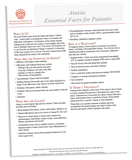Occupational Therapy / Ergotherapy
Role of the Occupational Therapist
For most patients with Movement Disorders, motor, cognitive and behavioral impairments lead to a loss of functional ability and independence in activities of daily living (ADL), which diminishes their quality of life (QOL).
Occupational therapy (OT) involves using contextually appropriate functional activities to enhance participation in roles at home, school, workplace, and community.
OT uses three approaches:
- Working directly with the patient (individually or in a group);
- Modifying the task and/or environment to accommodate the patient's limitations at the same time presenting a therapeutic challenge;
- Working with the patient's caregivers to ensure appropriate follow-up of the therapeutic program and promote mechanisms to cope with disability.
View complete description
OT practitioners administer standardized assessments of motor skills (posture and balance, transfers, mobility, hand function), daily living skills (feeding, toileting, dressing, bathing), process skills (initiation, sequencing, organization, adjustment, etc.), instrumental ADL skills (driving, cooking, cleaning, shopping, etc.) and QOL.
OT promotes health and wellness in patients through functional training of motor skills (bed mobility and transfers, balance and mobility, reducing fall risk, and improving hand function), process skills (organization and task adaptation), and psychosocial adaptation. To maximize function, OT performs task modifications (use of adapted utensils, built-up handles, adaptive clothing), environmental modifications (rearranging furniture, organizing ramps and walk-in shower, grab bars), and prescription of assistive devices (raised toilet seats, walking aids, splints, and braces).
In addition, OT teaches people the techniques and strategies to learn new and adaptive ways to perform basic daily activities and achieve independence in all facets of their lives, giving individuals the "skills for the job of living" necessary for independent and satisfying lives.
Originally contributed by Margarita Makoutonina and Ashwini Rao, Ed.D., OTR; Maintained by the Health Professionals SIG.
Tools
 Patient Handout: Gait Disturbances and Freezing
Patient Handout: Gait Disturbances and Freezing
This informational 1-sheet handout is available in 40+ languages.
Related Media
![]()
![]()
![]()
![]()






